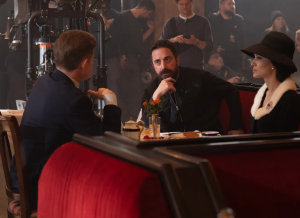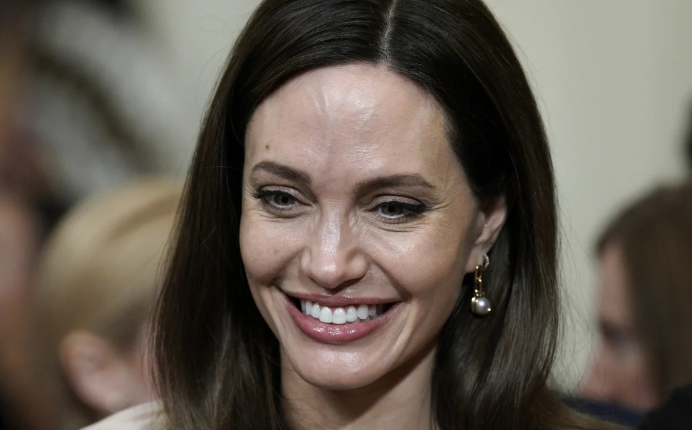pablo Larraín had met Angelina Jolie a few times over the years, and hoped one day to make a movie with her. In 2021, just as he’d wrapped post-production on Spencer, his disorienting portrait of Princess Diana, the Chilean director had found just the project—his next English-language movie. “I talked to Angie and said, ‘Look, I’d like to make a movie with you. I won’t tell you what it is, but please go and see Spencer,’” he tells me. Larraín rented out a screening room on the Paramount lot for Jolie to see the movie, featuring Kristen Stewart in an Oscar-nominated turn, and awaited Jolie’s reaction. She watched, called him up, raved and raved, and told him she wanted to work together. Larraín did not hesitate in his reply: “Would you play Maria Callas?”

Jolie was taken aback. She took a few days to think about it. She had just been asked to portray one of the most renowned opera singers of the 20th century by a filmmaker known for creating emotionally intense, unrelenting, and dreamlike character studies. By the time she said yes, though, she’d fallen in love with the idea. And so Maria, set to premiere next week at the Venice Film Festival, took shape. Spencer’s screenwriter, Oscar nominee Steven Knight (Dirty Pretty Things), wrote the script knowing Jolie would play the part. Larraín, who grew up going to the opera in Santiago with his mother, immersed himself in Callas’s voice and devised a “musical map” for the film, with her work providing the movie’s entire soundscape. And Jolie began her own training, which lasted over six months in total—and resulted in a defining, crowning, at times staggering performance.

Larraín describes Maria as the conclusion to his trilogy of biopics about iconic historical women. Spencer, Maria, and the originator of this series, Jackie—in which Natalie Portman played the first lady in the immediate aftermath of JFK’s assassination—all pinpoint their subjects at moments of profound internal distress while the world scrutinizes their every move. Maria takes place in ’70s Paris near the end of Callas’s life (she died of a heart attack at 53). “She became the sum of the tragedies that she played on stage,” Larraín says. “The movie is about someone who, after dedicating her life to the audiences around the world that would listen to her, decides to find her own voice, her own identity, and finally do something just for herself.”
Callas is not, of course, quite as famous as Jackie or Spencer, and the movie takes care to introduce her to less informed viewers. Born in New York to Greek immigrants, Callas grew up in poverty and sang at her mother’s behest for money, before her singular skills as a soprano launched her career in Italy. She battled mental and physical health struggles all her life while pushing opera forward in the popular imagination, amid its turn toward elitist circles. (As the movie demonstrates, at least in ’70s Paris, she was very famous.) Shot on film by Edward Lachman (Oscar-nominated earlier this year for Larraín’s El Conde), Maria cuts between striking color photography in the present, as our struggling heroine returns to voice lessons amid rumors of a comeback, and cool black-and-white flashbacks that showcase Callas at the height of her powers while deep into her love affair with Aristotle Onassis (Haluk Bilginer)—the shipping magnate who, in a nice bit of full-circle storytelling from Larraín, eventually left Callas to marry Jackie Kennedy.
Jolie’s approach to her character is simultaneously heartbreaking, erratic, and imposing, displaying a cellular kind of understanding of Callas’s desperation to reclaim herself before it’s too late. “This is the greatest diva of the 20th century, and who could play that?” Larraín says. “I didn’t want to work with someone that didn’t have that already. I needed an actress who would naturally and organically be that diva, carry that weight, be that presence. Angelina was there.” He describes her preparation as “very long, very particular, very difficult.” She worked on posture. She studied breathing. She developed an accent befitting a woman of both the world and another plane of fame. Then came the voice lessons.
yes, that really is Angelina Jolie singing, although not just her. Larraín and his star worked closely with Oscar winner John Warhurst (Bohemian Rhapsody, the upcoming Michael), who as Larraín puts it has “dedicated his life to actors who sing in movies,” to create innovative, synthesized recordings.Over months, Jolie learned her subject’s cadence and her signatures. Eventually, she got to the point where she’d hear the operas in an earpiece while singing them herself. Larraín and Warhurst would record Jolie’s performance, then mix it with Callas’s. “You always listen to Angelina and you always listen to Maria Callas,” as Larraín puts it. “When we listen to Maria Callas in her prime, most of the sound is Callas—90%, 95%—and when we listen to Callas older and in the present, almost all of it is Angelina.” Worth noting: The bulk of the film takes place in the present.
Larraín describes seemingly contradictory tasks. One: “How can you make a movie about Maria Callas without using her voice? You can’t.” And two: “You can’t make a movie like this with an actress that is not actually singing it.” It’s not karaoke, he stresses. “This is the real thing—it was very scary for her, but she did it.” When they finally got to filming, Larraín noticed just how deep his star had gone—appropriate, maybe, given the rawness of the material and the extent of training Jolie completed before actually being able to attack it. A few weeks in, Larraín stopped giving Jolie instructions. The best direction was silence; the best note was no note. “It was so truthful, we just kept rolling and let her do her thing,” he says. “She can let you in when she wants, and she can create a distance where she wants. It’s a dance of vulnerability.”
larraín takes an unusual hands-on approach to his sets: He acts as his own camera operator. So even as he gave Jolie her space, they were connected. “It’s very intimate because this is a film where the camera is often very close to her—so we were together all the time,” Larraín says. “Sometimes she would feel me. We would complete a take and she would look at me, just by the way I would look at her.” He calls their dynamic “sensorial.”Capping Larraín’s makeshift trilogy, Maria is the most deeply felt and wholly realized of the films. Credit certainly goes to Jolie’s searing turn and the movie’s immaculate craft—you’ll remember while watching that Lachman, best known for lensing Todd Haynes’s Carol and Far From Heaven, is a master of period cinematography—and the score being driven by an opera legend imbues Maria with tremendous emotion. Yet it ultimately comes down to the director’s vision. Larraín’s exacting approach to these biopics has drawn critical acclaim, but the actors at their center tend to, inevitably, gobble up the attention (and awards recognition). That ought to change here. This may be the most personal film Larraín has ever made.His initial way into Maria was rooted in a longstanding desire to make a movie about an artist. “As she was singing, she was living everything she had been through on the stage,” Larraín says. “That’s why she was also very respected, not only because of the quality and the color and the specificity of her voice, but also the way she performed.” He says capturing that on film felt exposing. How? “I connected through how the crafting of your work can sometimes be devastating,” he says. “Even though this is the story of a woman that lived from the ’20s to the ’70s and had a completely different life from me, there is a fragility that is unavoidable. It’s impossible to hide yourself.” He continues, “She burned her voice, her life, by doing her work—and I think that I burned myself a little bit doing this.”
